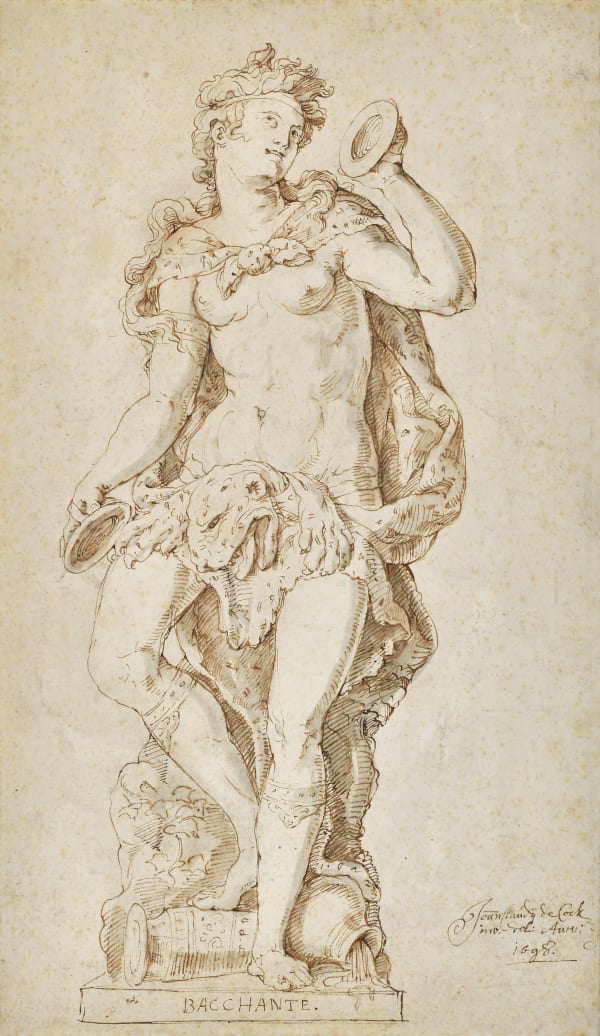Jan Claudius de Cock (Brussels 1667 - 1736 Antwerp)
Bust of a Young Boy
white marble
height 23 cm (29 cm including the base)
%3Cdiv%20class%3D%22artist%22%3EJan%20Claudius%20de%20Cock%20%28Brussels%201667%20-%201736%20Antwerp%29%3C/div%3E%3Cdiv%20class%3D%22title_and_year%22%3E%3Cspan%20class%3D%22title_and_year_title%22%3EBust%20of%20a%20Young%20Boy%3C/span%3E%3C/div%3E%3Cdiv%20class%3D%22medium%22%3Ewhite%20marble%3C/div%3E%3Cdiv%20class%3D%22dimensions%22%3Eheight%2023%20cm%20%2829%20cm%20including%20the%20base%29%3C/div%3E
De Cock and his workshop are thought to have produced several versions of this expressive model in various media including bronze, plaster, and marble. Versions can be found in the...
De Cock and his workshop are thought to have produced several versions of this expressive model in various media including bronze, plaster, and marble. Versions can be found in the Victoria & Albert Museum (inv. no. A18-1913) and The Walters Art Museum (inv. no. 2053), among other collections. Of the known versions, none are identical, varying principally in the decoration on the medallion. These busts may have been carved in the workshop and then completed with a medallion decoration customized to reflect the wishes of the purchaser. The present version shows a galero, or cardinal’s hat, on the face of the medallion, one sold at Christie’s, New York, 10 June 2022, lot 27 was adorned with a crown, the one from the former collection of the Duc de Talleyrand had a profile after the Antique (this latter sold Christie’s, Paris, 26 November 2005, lot 288).
De Cock's choice of a black subject for the bust may be unusual, but African people, particularly young men and boys, were not an uncommon sight in cosmopolitan Antwerp where de Cock spent much of his working life. The city's historic trading links and increasing involvement in the transatlantic slave trade contributed to the growth of a black community. A similar, full-length version of a young boy by Jan de Cock is in the Rijksmuseum (inv. no. R.B.K. 1972-134); this shows the figure with a headdress and band of feathers hanging on the chest with the medallion. Thanks to this sculpture, signed by the artist, it was possible to associate the group of busts with de Cock's workshop.
Marble busts depicting Black Africans were popular throughout Europe in the 17th and 18th centuries. They were produced widely in Venice and Rome, often taking pride of place in wealthy homes. De Cock is one of the few Northern sculptors who produced similar objects in the Low Countries. Today, these sculptures may serve to underscore the importance of including all of our voices in retelling collective historical narratives.
A note on the provenance
The bust belonged to Loelia Mary, Lady Lindsay, née Ponsonby (1902-1993). Daughter of Sir Frederick Ponsonby, she married Hugh Grosvenor, 2nd Duke of Westminster (1879-1953) in 1930. A notable British socialite, needlewoman, and magazine editor, she was part of the so-called Bright Young Things, a famous group of young aristocrats in 1920s London. Her portrait was shot by the noted photographer Cecil Beaton.
Provenance
Lady Lindsay née Ponsonby, Duchess of Westminster (1902-1993);
Private collection, France.
Share
- Tumblr
Copyright © 2024 Galerie Lowet de Wotrenge

